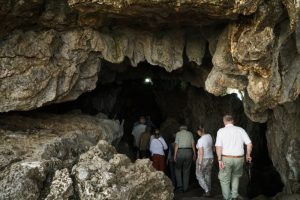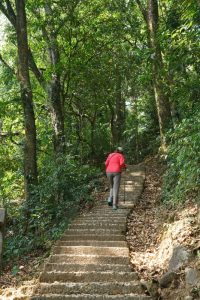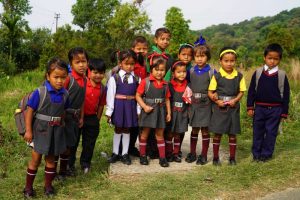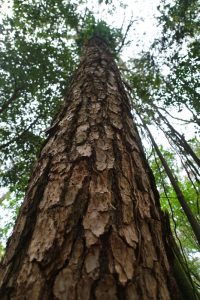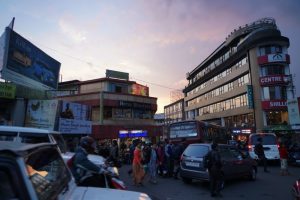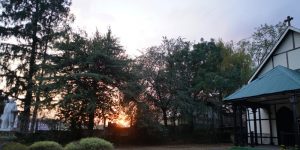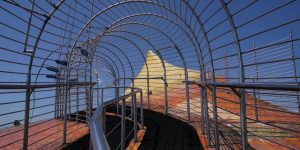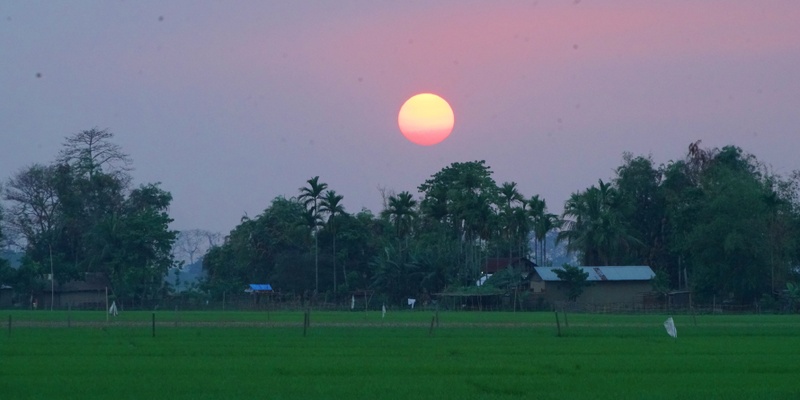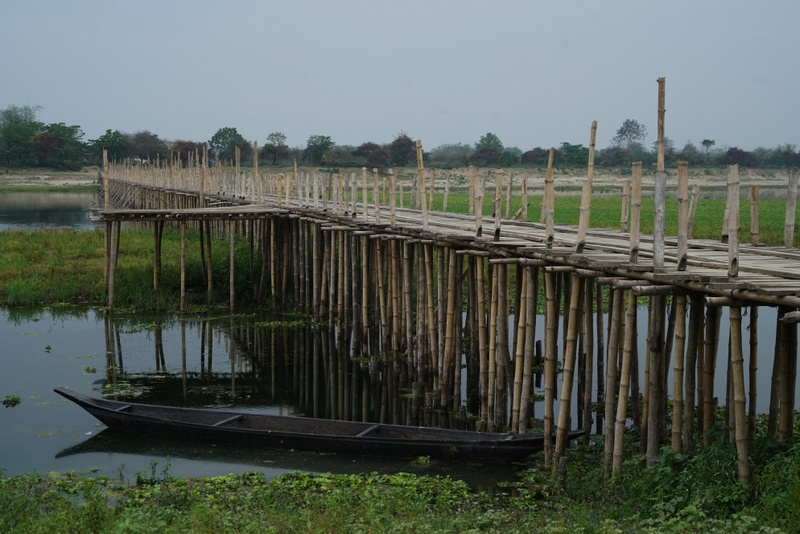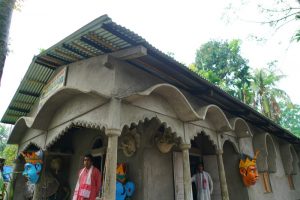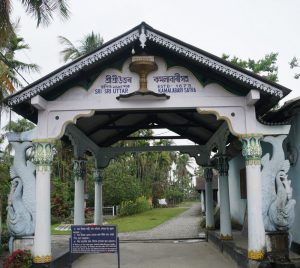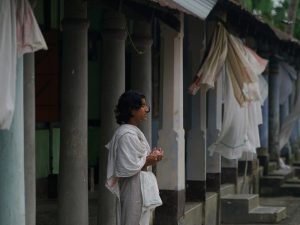March 25 – 31 Cherrapunjee, Shillong, Kaziranger National Park & Majuli Island
Day 2 Monday: Drive to Cherrapunjee, Meghalaya (about 150km)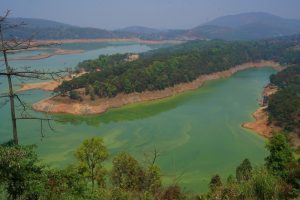
Meghalaya (Cherrapunjee) meaning “the abode of clouds” in Sanskrit. The estimated population of the state was over 3.2 million in 2016. Also known as Sohra, Cherrapunjee is the only place in India to receive rain throughout the year and one of the wettest places on the planet recording an average of 470 inches of rain a year. The heavy monsoon rains over these mountains, create one of the rarest bio-diverse vegetation in the world. About 70% of the state is forested.
We left the hotel after 8:30 am. Navin arranged us to travel in two vehicles. Another Exodus guide from Agra, AJ joined to prepare himself to lead groups in future. We had a leisure day with four stops.
- Umiam Lake (also known as Barapani Lake). This reservoir was created by damming the Umiam River in the early 1960s. The water looked eerily green. I hope it is safe for consumption!
- Lunch stop. I had vegetable fried rice which is surprisingly good and cheap (R160).
-
Nohkalika Falls. It is the tallest plunge waterfall in height (340m). But it looks like a thread from a distance as there is not much water before the monsoon season.
- Mawsmai Caves. Visitors are allowed to enter the underground cave system from one end, walk 150m and exit from another end. The stalactites and stalagmites mostly grey in colour, have innumerable forms, shapes, and sizes. The passage is very narrow at two sections. I had to lower my hand to get through.
Shortly after 6 pm, we arrived at Cherrapunjee Holiday Resort in the Laitkynsew Village. The resort run by a man from Tamil Nadu is nice, clean and comfortable. The owner who saw tourism potentials of the living root bridges has succeeded over the years in promoting the area as a tourist destination.
Day 3 Tuesday: Trek to Double-decker Living Root Bridge (8km)
Living root bridges are a form of tree shaping common in the southern part of Meghalaya. They are handmade from the aerial roots of rubber fig trees by the Khasi and Jaintia peoples. There is a 250-year-old double-decker living-root bridge spanning between two grand old rubber trees in the remote village of Norgriat which only be reached on foot.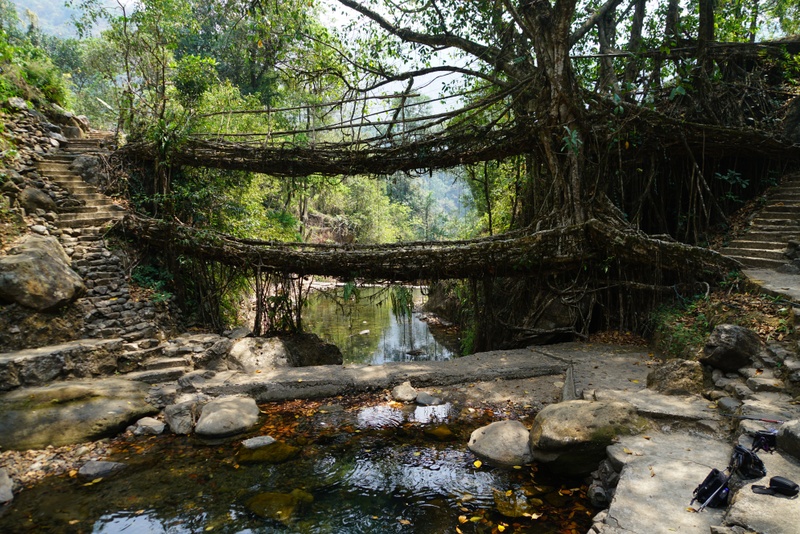
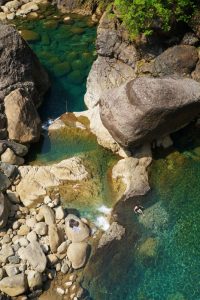 Our minibus dropped us at the top of the trail and 12 of us followed a young local guide to see this phenomenal tree. I followed a series of steep stone steps (possibly around 1,000 steps) all the way down descending to a river valley. I passed by a village with friendly locals.
Our minibus dropped us at the top of the trail and 12 of us followed a young local guide to see this phenomenal tree. I followed a series of steep stone steps (possibly around 1,000 steps) all the way down descending to a river valley. I passed by a village with friendly locals.
I crossed a steel bridge. Then I had to climb a series of steep steps before descending to another river valley. I crossed another bridge.
More steps ahead! I saw my first living root bridge by a house. Then I climbed more steps again!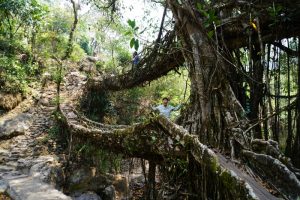
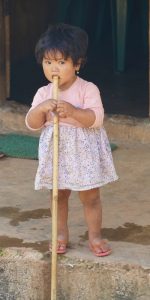 There are more houses just before the double-decker bridge. Tourism has been an economic drive: there are several new homestays and coffee/tea stalls.
There are more houses just before the double-decker bridge. Tourism has been an economic drive: there are several new homestays and coffee/tea stalls.
I walked at my pace with the support of a pair of walking poles. Well, I took less than two hours to reach the bridge covering about 3.5km and taking some 2,400 steps.
I walked across the bridge several times looking at it from all angles. There is a pool in front and behind it. I sat by a pool to enjoy this nature wonder.
Jeff who has a hip replacement was the last to arrive. I left with Claire and Jeff after spending over half an hour I must have spent over half an hour at this attraction.
 We spent another 20 minutes enjoying a local coffee in a tea stall. Then I began a strenuous climb following the same steps back to the car park.
We spent another 20 minutes enjoying a local coffee in a tea stall. Then I began a strenuous climb following the same steps back to the car park.
The hike is challenging especially in the heat. I was glad to complete the hike around 2 pm. Unfortunately, the first minibus with seven group members had just left. The second and last bus would only leave when the last member was back.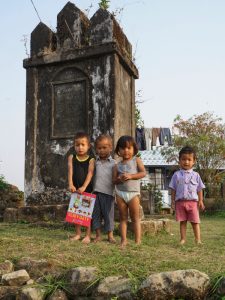
After waiting for an hour, I decided to walk so that I could see something along the road. I walked for half an hour before being picked up by our minibus.
 It was still early. Vicky and I had a leisure stroll around the Laitkynsewe Village before sunset. Most of the residents here are Christian. This village is the tidiest and cleanest one I have visited in India: all the houses, big and small, old and new, are well-maintained with nice garden. There are a couple of schools in the village and we learn that many teachers with good salaries are living here.
It was still early. Vicky and I had a leisure stroll around the Laitkynsewe Village before sunset. Most of the residents here are Christian. This village is the tidiest and cleanest one I have visited in India: all the houses, big and small, old and new, are well-maintained with nice garden. There are a couple of schools in the village and we learn that many teachers with good salaries are living here.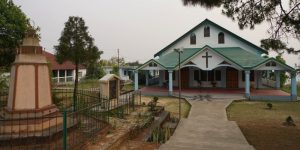
We were surprised to find a modern building in the village which turns out to be a museum on the village’s most famous person, George Gilbert Swell (1923 – 1999). Born in the village, he had a distinguished career as a college professor, a diplomat, a former Deputy Speaker of the Lok Sabha and its member from Shillong. Above all, he was a candidate in the 1992 presidential election.
Day 4 Wednesday: Mawphlang Village & Shillong (125Kms)
We learnt about a less famed living root bridge which is worth visiting. This bridge is being trained and formed into another double decker bridge. As it is located only 3.5 km from the resort, many of us decided to go to see it before the group set off at 9 am.
The resort owner showed us a sketch map and said it was a flat walk. I set off at 6:10 am with Lesley, my roommate. Though the road is not very steep, it is not a flat walk at all. When we were approaching a school, we saw sign for a living root bridge. We followed a series of steps down to a river valley. But after walking for 10 minutes, we sensed something was wrong. We gave up the idea and climbed a series of steep steps back to the main road. Others who set off ten minutes later had made the same mistake. So, none of us found the bridge.
 We all got back to the hotel around 8:30 am. I told the owner his instruction and the sketch map were wrong. He should update the map and simply tell visitors to look for the car park near the school. Had we known it was not a flat walk, we could have arranged a taxi.
We all got back to the hotel around 8:30 am. I told the owner his instruction and the sketch map were wrong. He should update the map and simply tell visitors to look for the car park near the school. Had we known it was not a flat walk, we could have arranged a taxi.
This morning, we would visit a Sacred Forest in Mawphlang on our way to Shillong. A local guide whose name is March Born Well belonging to the ruling family of Lyngdoh, greeted and explained the significance of the forest to his ancestors. He showed us a tree that can cure cancer. Ritual sacrifice had once been practiced in the forest with a number of sacrifice stone tables. But such practice has ceased for a long time.
We visited a park containing half a dozen huts from the region. They are in poor condition. I gather these huts must have been built in connection with a festival held in 2016 with the participation of indigenous people from other parts of the world.
Our guide prepared a simple lunch (R200pp) with fish and chicken. We set off around 1:30 pm and arrived in Shillong an hour later. It started to rain heavily. We checked in the Gateway Hotel near Center Point, the heart of the city
Shillong, a hill station situated at an average altitude of 1,496m above sea level, is the capital city of the state of Meghalaya, as well as the headquarters of the East Khasi Hill district. Reputable educational institutions were established by various missionary groups, making Shillong the hub of education for the entire north-east. It is also home to several waterfalls and is referred to as ‘the Scotland of the East‘. British influence is still visible in the architecture and cuisine.
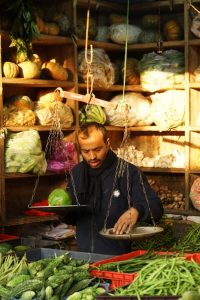 Navin’s original plan was to arrange an orientation walk at 4 pm with a local guide. Unfortunately, the guide could not turn up owing to the rain. Navin therefore showed us the way to the Centre Point. We had free time to explore the city for the rest of the day.
Navin’s original plan was to arrange an orientation walk at 4 pm with a local guide. Unfortunately, the guide could not turn up owing to the rain. Navin therefore showed us the way to the Centre Point. We had free time to explore the city for the rest of the day.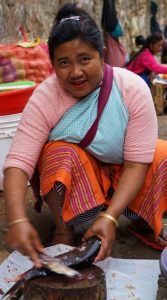
Shillong is a bustling town with a population of about 200,000. Half a dozen roads spread out in all directions from the Centre Point. I explored a small street market nearby with plenty of fresh vegetables and fish. All fresh produce is laid neatly on the floor. One girl had some 40 types of vegetables laid on a ground mat!
I saw the wooden All Saints Church (over 200 years old) but it was closed. Then walked to the Bara Bazaar an enormous sprawling market place spreading out along a main road and branching out like veins into all the nearby narrow alleys and side streets. There are hundreds of shops and street stalls and thousands of shoppers.
It started to rain again. I even bought 600 gm of good quality Assam tea from a tea merchant. At 7 pm, I met up with Lesley, Vicky and Patricia at Centre Point and had dinner in a modern nice restaurant.
Day 5 Thursday: Don Bosco Museum, Shillong – Kaziranga National Park, Assam (250km)
We set off at 8:30 am for the Don Bosco Centre on Indigenous Cultures, a three-in-one institution combing a museum with a research and publication centre for promoting and preserving the rich cultural heritage of NE India. As the traffic was terrible, we wasted an hour on a 3-km journey. We had an hour and a half to visit the museum in a hexagonal shape. Its seven floors represent the seven states of NE India and have 17 galleries.
The tribes have originated from the ethnic groups of Tibeto-Burmese, proto Austrioloids and some groups from Indo Mongoloids. The prominent tribes including Garo, Khasi, Jaintia, Adi, Nyishi, Angami, Bhutia, Kuki, Rengma, Bodo and Deori, scatter throughout the region. They all have their own culture and tribal tradition and speak their own languages. This has made NE India one of the most culturally diverse regions of the world. Christian-ism is followed among many of the tribes and some also follow Hinduism and Buddhism. The rest have their indigenous beliefs and practise animism.
I particularly like the collection of bamboo baskets and fish traps. The panoramic views at the roof top are most fantastic.
We had a nice lunch in a vegetarian restaurant. Then we had a long drive mostly on good paved roads. We did arrive at La Vue Resort close to the Kaziranga National Park after 6 pm. We saw a beautiful sunset from the minibus.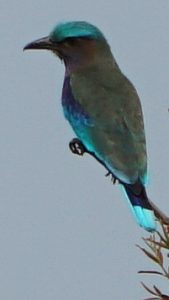
Day 6 Friday: Kaziranga National Park
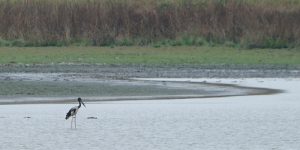 Kaziranga National Park with an area of 430km2 and home to some 2400 one-horned rhinoceroses (estimated to be two-thirds of the world’s rhino population), is a World Heritage site. It is also a tiger reserve with an estimated population of 120.
Kaziranga National Park with an area of 430km2 and home to some 2400 one-horned rhinoceroses (estimated to be two-thirds of the world’s rhino population), is a World Heritage site. It is also a tiger reserve with an estimated population of 120.
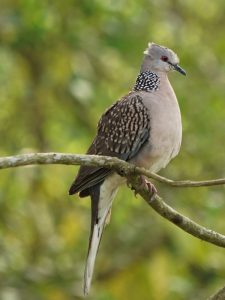 The landscape consists of pristine forest, tall elephant grass, reeds, marshes and shallow pools. It is also home to a large breeding population of elephants, wild water buffalo and swamp deer and an important bird area.
The landscape consists of pristine forest, tall elephant grass, reeds, marshes and shallow pools. It is also home to a large breeding population of elephants, wild water buffalo and swamp deer and an important bird area.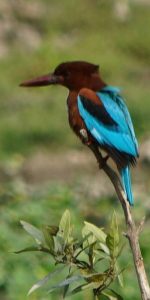
We had two jeep safaris. The morning drive in the western part of the park started at 7 am and finished around 11 am. The weather was perfect with a light breeze. We were thrilled to see our first rhino. By the end of the day, we must have seen over 30 rhinos!
The most wonderful rhino moment of the day was during the morning drive. We had been watching a rhino feeding on grass by the roadside for some 15 minutes. Suddenly it charged forward and all vehicles moved away to leave it a path to cross the road. It walked just in front of our 4WD to go to a spot which is his loo! The guide told us that rhinos have their own loo and return to the same spot every day!
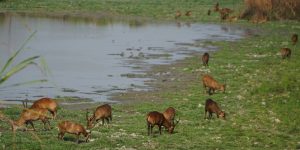
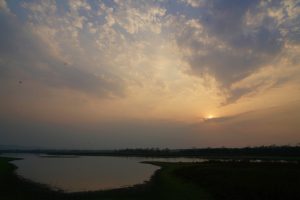 After a rest and a light lunch at the hotel, we set off for the centre zone at 1:45 pm. We saw many rhinos again.
After a rest and a light lunch at the hotel, we set off for the centre zone at 1:45 pm. We saw many rhinos again.
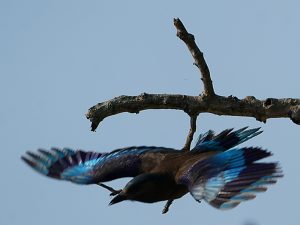 Our guide took us to a watch tower by a lake where tigers are often seen around 4 pm. Several groups of visitors were at the tower waiting anxiously. The sun was setting. I enjoyed the scenery. But there is no bench to sit and no wine to drink. In this regard, the safari in Africa offers more comfort and is more enjoyable!
Our guide took us to a watch tower by a lake where tigers are often seen around 4 pm. Several groups of visitors were at the tower waiting anxiously. The sun was setting. I enjoyed the scenery. But there is no bench to sit and no wine to drink. In this regard, the safari in Africa offers more comfort and is more enjoyable!
Today, the tiger did not make a grand entrance. It must be on holiday or already had a full stomach. We left the park around 4:30 pm. What a pity I missed a chance a tiger in the wild!
Day 7 Saturday: Crossing Brahmaputra River by Ferry to Majuli Island (150km)

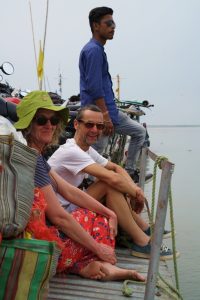 We drove about two hours to reach Nimati Ghat where we boarded a local ferry to cross the mighty Brahmaputra River, one of the major rivers of Asia, a trans-boundary river that flows through China, India and Bangladesh. While most rivers on the Indian subcontinent have female names, this river has a rare male name i.e. “son of Brahma”. With its origin in the Manasarovar Lake in Tibet, China, it is about 2,900 km long and merges with Ganges River in the Ganges Delta before emptying into the Bay of Bengal. It is navigable for most of its length.
We drove about two hours to reach Nimati Ghat where we boarded a local ferry to cross the mighty Brahmaputra River, one of the major rivers of Asia, a trans-boundary river that flows through China, India and Bangladesh. While most rivers on the Indian subcontinent have female names, this river has a rare male name i.e. “son of Brahma”. With its origin in the Manasarovar Lake in Tibet, China, it is about 2,900 km long and merges with Ganges River in the Ganges Delta before emptying into the Bay of Bengal. It is navigable for most of its length.
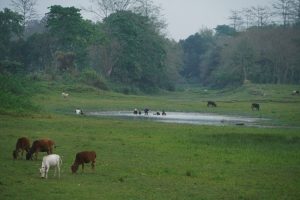 Majuli Island with an area of 925 sq. km is the largest river island in the world. It is renowned for the Mishing tribal culture.
Majuli Island with an area of 925 sq. km is the largest river island in the world. It is renowned for the Mishing tribal culture.
The island has been a principle place of pilgrimage for Vaishnavites (followers of Lord Vishnu) since the age of the Ahom rulers. There are 22 Hindu temples and several satras (monasteries and hermitages) resembling those of mediaeval times and headed by Satradhikars who teach Vaishnavism.
The ferry crossing took about an hour. The island has a population of approximately 200,000. We were met by Lithnu, a 42-year-old monk, who would be our local guide. We soon arrived at Me-Po Okum Eco Resort and paid R100 for a snack lunch.
After lunch, we went to see India’s longest bamboo bridge (about 400m in length). Every year the bamboo poles would be pulled up and stored away before the monsoon season. Locals would have to cross the stream by boat.

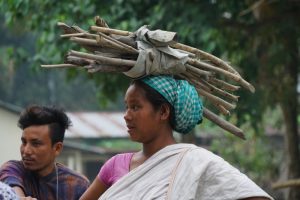 Today’s highlight was our visit to a Mishing tribal village with about 120 families near the bridge. The Mishing tribe comprises 45% of Majuli’s population. Their ethnic culture remains unchanged for centuries. They live in pillar houses, which are generally stilted and have a thatched roof. In this way, they would not be affected by flooding. They are farmers and keep livestock in their yard.
Today’s highlight was our visit to a Mishing tribal village with about 120 families near the bridge. The Mishing tribe comprises 45% of Majuli’s population. Their ethnic culture remains unchanged for centuries. They live in pillar houses, which are generally stilted and have a thatched roof. In this way, they would not be affected by flooding. They are farmers and keep livestock in their yard.
The tribal people are known for their weaving tradition. The looms are normally placed underneath the house. We watched a few ladies working on their looms and were keen to take their photos.

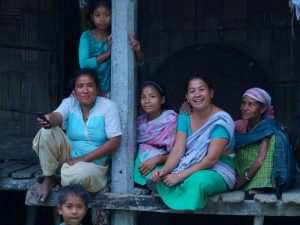 The NE India is still off the beaten track and few tourists travel to Majuli Island. Lithnu said we must be the largest group of tourists that visited the village. The villagers looked at us with curiosity too.
The NE India is still off the beaten track and few tourists travel to Majuli Island. Lithnu said we must be the largest group of tourists that visited the village. The villagers looked at us with curiosity too.
We had a nice dinner with chicken and fish. Then torrential rain, lightning and thunder arrived without forewarning. We soon lost power. Luckily, I had a headlamp next to my pillow. I started to cough badly at night. The deafening thunders and my cough kept me awake.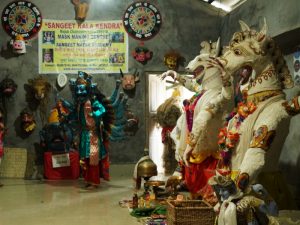
Day 8 Sunday: Majuli Island
Apparently, the power line had been pulled down by falling trees. We ended up having a candle-light breakfast. It was raining and the early morning bird watching walk had to be cancelled.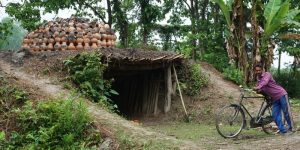
Luckily, the rain did not affect our programme. We visited three satras which are the Assamese Vaishnavites monasteries founded at the initiatives of the Ahom Kings of Assam in the middle of the 17th century. They are centres of learning, art and culture and for religious practices.
 We first visited the Chamaguri Satra to see mask making. The family with a few kids performed religious dance.
We first visited the Chamaguri Satra to see mask making. The family with a few kids performed religious dance.
Then we stopped in a village famed for pottery making. We watched a lady making clay pots.
The third stop was Uttar Kamalabari Satra (1673) with some 60 monks including some young boys. They all wear long hairs. This temple keeps no idol or image but two copies of the Gita, a 700-verse Sanskrit scripture that is part of the Hindu epic Mahabharata (chapters 23-40) in the main hall.
The last stop was the Auniati Satra (1653), established by the Ahom King Sutamla. It is the largest and oldest temple on the island. The idol in this temple is Lord Krishna (called Govinda) which was originally brought here from Jagannath Temple in Puri.
Each satra has an unknown wealth of Vaishnavite scriptures and extensive revenue-free lands cultivated by the Bhakats (celebrated monks) of the satras. Today, the Auniati Satra has some 350 monks living in 96 self-contained cells.
Lithnu arranged us to have a vegetarian lunch in his cell. We were surprised to see each cell shared by several monks is spacious with a couple of rooms, a kitchen and toilet. They meditate and pray in a corner of the common area of the cell.
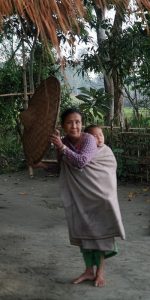 After a late lunch, we returned to the resort. On the way, I stopped at a pharmacy to get a bottle of cough syrup. Navin who was expecting bad weather, did not take us on a village visit. We looked up and did not think rain would be coming soon. We decided to take a walk on our own. Alas, after strolling for about 200m, we watched the sky darkened and locals running home with their cows. It was dramatic! We rushed back to the resort just before it started to rain. We should have trusted Navin’s judgement.
After a late lunch, we returned to the resort. On the way, I stopped at a pharmacy to get a bottle of cough syrup. Navin who was expecting bad weather, did not take us on a village visit. We looked up and did not think rain would be coming soon. We decided to take a walk on our own. Alas, after strolling for about 200m, we watched the sky darkened and locals running home with their cows. It was dramatic! We rushed back to the resort just before it started to rain. We should have trusted Navin’s judgement.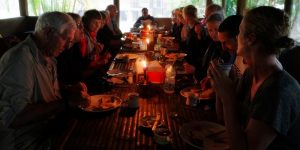
There was still no electricity till when we gathered for dinner. While we were enjoying a most delicious dinner with chicken and smoked fish, power returned. I kept coughing badly and did not sleep well.




